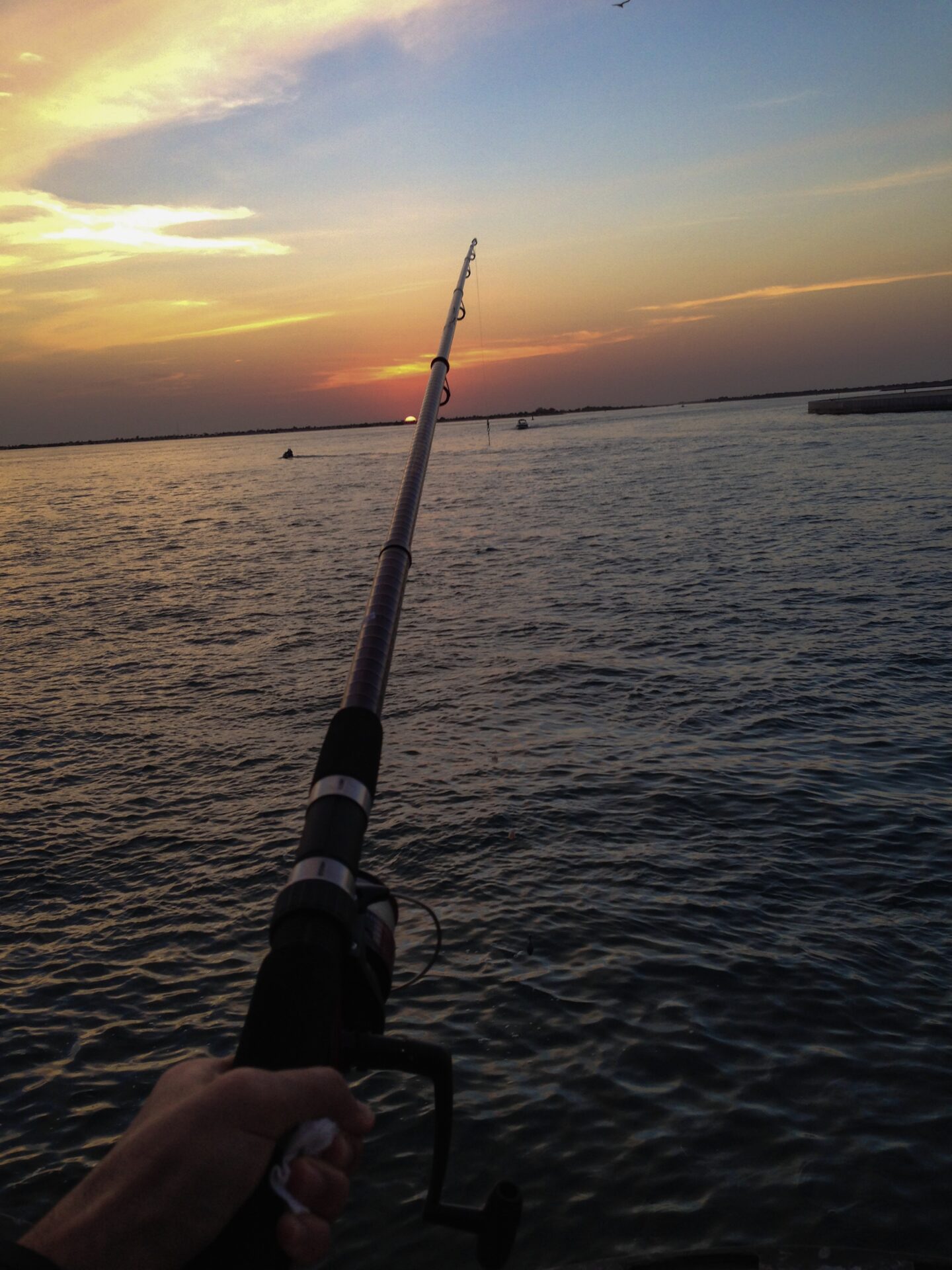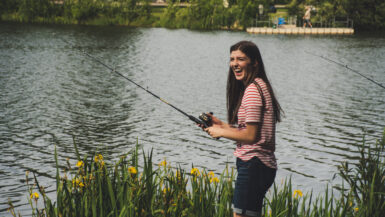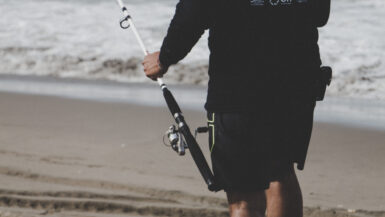For many freshwater anglers, the bluegill is a favorite target. Its size and willingness to take bait makes it an easy target for success. While most anglers typically use spinning or baitcasting tackle when bluegill fishing, fly rod fishing can be surprisingly effective in certain circumstances. With the proper setup and technique, a fly rod can be used to catch bluegill and other fish. In this article we will discuss the basics of fly fishing for bluegill, including the best tackle and fly choices, setting up the fly rod and the technique.
Choosing the Right Equipment
Before venturing out to fish with a fly rod, it’s important to prepare by having the right equipment. This includes not just the fly rod, but also the fly line, flies, tippet material, and other necessary items.
Selecting the Proper Fly Rod
When fishing for bluegill with a fly rod, it’s important to select a rod that can accurately cast the type of fly being used. When using smaller flies, such as those typically used to land bluegill, a shorter, lighter rod is preferable. A 6 to 7-foot, 4- to 6-weight rod is usually a good choice. Remember, the fly rod is the most important tool in the angler’s arsenal, so make sure to get one of good quality.
Buying the Right Fly Line
When buying a fly line for bluegill, it’s important to select one that is designed for the rod as well as the type of fly used. Generally, a weight-forward taper is ideal for bluegill fishing. Choose a floating line for topwater fishing, or a sinking line for fishing more deeply. A line with a heavy tip is also a good choice, as these will handle the wind better.
Picking the Appropriate Flies
When it comes to selecting the right flies for bluegill, small is usually better. Tiny poppers, nymphs, and terrestrials are ideal choices. It’s also important to choose a variety of colors and sizes to give yourself the best chances at success. Also, don’t forget to carry some split-shot, as they may be needed to get the flies down deep.
Essential Tippet Materials
A quality tippet material is essential when fishing for bluegill with a fly rod. Tippet material comes in different sizes, with the smallest generally being the best choice for bluegill. There are many different types of tippet materials available, including fluorocarbon and monofilament. Whichever type chosen, make sure it has a high breaking strength and is abrasion-resistant.
Other Gear for Fishing Bluegill
In addition to the equipment listed above, there are many other items that can be helpful when fishing for bluegill with a fly rod. These include waders, polarized sunglasses, a landing net, forceps, and a leader straightener, among other items. Many of these items are not absolutely necessary, but they can make fishing more enjoyable and successful.
By taking the time to select the right equipment and gear, anglers can be confident they have everything they need to effectively and safely fish for bluegill with a fly rod. Happy fishing!
Locating the Best Fishing Spots
Before attempting to fish for bluegill with a fly rod, it is important to find the best fishing spots. Researching potential fishing locations is the first step towards a successful fishing experience. A great way to find potential spots is to consult local fishing reports, as these give valuable insight into where bluegill may be congregating in a given region. Fishing reports also provide details regarding fly rod legality and whether or not a given area allows these types of rods.
Checking Out Local Lakes, Ponds, and Rivers
Local lakes, ponds, and rivers are great places to look for bluegill. These locations provide great opportunities to land bluegill, thanks to their shallow depth and abundance of insect life which draw the fish to the surface. Spotting bluegill in these areas can be done by simply looking for their tell-tale ‘tails’ wagging in the water. Once located, anglers can cast their fly rod in the area and wait for the fish to bite.
Experimenting with Different Depths
Bluegill can be found in many different depths, depending on the season and the water body. Experimenting with different depths is a great way to explore the possibilities for finding more bluegill. If there is no visible activity near the surface, anglers can try fishing deeper in the water column. For example, bluegill can often be found in deep pools of clear water, which can be challenging to reach with a fly rod. In this case, anglers should use heavier lines and longer casts to reach the deeper depths.
Choosing the Right Bait
Choosing the right bait is another important factor in finding the best fishing spots. Lures and flies should be chosen based on the type of bait the bluegill are attracted to in the area. Common bait choices include aquatic insects, worms, and small minnows. Anglers should experiment with different types of bait to find out what works best in their area. Additionally, they should ensure they have the appropriate gear, such as bobbers, weights, and line, to ensure bait is presented properly and that it reaches the right depth.
Utilizing Technology
Nowadays, anglers can take advantage of modern technology to identify potential fishing spots. Sonar fish finders and GPS systems can be used to locate bluegill congregating in a particular area, along with other fish species. Additionally, online resources such as forums and websites dedicated to fishing can provide useful tips and advice on where to find bluegill.
Finding Guides and Charters
For those interested in fishing for bluegill with a fly rod, finding a professional guide or charter is a great way to learn more about the sport. These professionals can provide valuable insight into the fishing locations they frequent, as well as tips and advice on how to catch more bluegill. Additionally, they can provide the right gear and equipment to ensure a successful fishing experience.
Rigging and Casting
Successful fishing for bluegill with a fly rod requires gathering the correct equipment in order to properly rig and cast. Fly fishing rods for bluegill can range from 3-weight to 6-weight, with a 5- or 6-weight rod being a good option for anglers. The length of the rod can vary depending on personal preference, though rods in the 8- to 9-foot range provide extra rod control and accuracy when casting a fly. Generally, a reel with a disc-drag system and a spool of weight-forward floating fly line are recommended when fishing for bluegill with a fly rod.
Choosing the Right Fly
When fly fishing for bluegill, the type of flies used can have a major impact on success. Poppers are a popular fly used when targeting bluegill, as they often elicit a strong strike when presented properly. Nymphs, however, can also be effective when fishing for bluegill. The best type of fly for bluegill can vary depending on the season and water conditions, though basic patterns like the Woolly Bugger and the Copper John are often a good choice.
Mastering the Presentation
Fly fishing for bluegill is more than just casting and retrieving. Proper presentation is essential in order to catch bluegill with a fly rod. It is important to cast the fly near any visible structures like submerged logs, rocks, lily pads, or aquatic vegetation. Once the fly has landed, wait until the ripples have dissipated before gently twitching the fly for added effect. When the bluegill takes the fly, be sure to set the hook by raising the rod tip quickly.
Reeling Them In
Once a bluegill has taken the fly, the main goal is to reel it in carefully. Bluegill can put up a good fight and can be easily lost due to their small size, so it is important to take one’s time and reel slowly. Use a netted or a landing glove to make the process easier, as bluegill often dart and jump when they are near the shore.
Effective Fishing Techniques
When fly fishing for bluegill, it is important to have the right set-up. A 9′ 5-weight or 6-weight rod is ideal for fly fishing for bluegill. You also need a good quality reel that is reliable and can hold enough line for the fish you are targeting. Other items you will need are a floating line, a leader and some tippet, a selection of flies, and a net.
Casting for Bluegill
Once you have the right gear, you need to know how to cast effectively. When fly fishing for bluegill, it is important to use short casts, as they are very sensitive to line disturbance. Try to keep your casts as short and accurate as possible. The key is to place the fly exactly where you want it to be. You should also use a gentle presentation since bluegill are not very aggressive.
Locating Bluegill
To have a successful trip, you need to know where to look for bluegill. Bluegill typically inhabit areas near the shore that are close to cover like weeds or structure, such as fallen trees and sunken logs. They also like shallow water, so look for areas that are no deeper than 3 feet. Look for areas with lots of bugs and insects, as this usually indicates that bluegill are present.
Fly Patterns for Bluegill
When it comes to choosing the right fly pattern, it is best to stick with simple patterns. Small dry flies, nymphs, and poppers are all effective for bluegill. Size 8 and 10 dry flies, nymphs, and poppers are the best size to use, as they are the perfect size for bluegill. Some good fly patterns to use are foam ants, olive woolly buggers, and chartreuse poppers.
Retrieving the Fly
Once you have cast your fly, it is important to use the right retrieving technique. When you feel a bite, it is important to wait a couple of seconds before setting the hook to give the fish time to swallow the fly. When retrieving the fly, use a slow and steady motion. If the fish are not biting, try changing the speed and direction of your retrieve.
Landing the Fish
Once you have hooked the fish, the next step is to land it. When it comes to landing, a net is the best tool. When using a net, try to encircle the fish as much as possible and make sure to keep the net low in the water to keep the fish from jumping out. If you are unable to use a net, you can also try to beach the fish by walking it to shore and holding it in the shallow water.
Landing and Releasing Bluegill
Fishing for bluegill with a fly rod is an enjoyable and rewarding experience for any angler. The key to success is to properly lure the bluegill to the line. Bluegill are attracted to brightly colored lures, so it’s best to choose a variety of colors and sizes when selecting a fly for the rod. Additionally, bluegill prefer smaller flies for the same reason that they like bright colors. The small size of the fly will attract the attention of these relatively small fish, prompting them to take the bait.
Casting Your Line Successfully
Once you have the right lure and fly in hand, you’ll need to cast your line in order to actually catch the bluegill. When casting the line, it’s best to make a wide arch and aim towards the shallowest part of the body of water. This will increase the chance of the bluegill seeing your lure and flocking towards it in search of a meal. Additionally, be sure to slowly reel in the line while giving the bluegill time to take the bait.
Landing the Bluegill
Once the bluegill has taken the bait and you feel a tug on the line, it is time to start reeling in the line. Here, it is important to be gentle and not rush the process. Slowly reel in the line, but do not pull too hard as this might scare off the bluegill or break the line. Additionally, be patient as bluegill are notorious for putting up a fight. After persistence and patience, the bluegill should eventually make it to the surface and can be netted with ease.
Releasing Bluegill Successfully
Once the bluegill has been safely netted, it is important to properly release the fish back into the body of water. If keeping the bluegill for consumption, keep them in a cooler with a wet cloth before transporting them. If releasing the fish back into the wild, gently remove the hook before submerging them into the water. Additionally, be sure to not overly handle the fish as this can cause damage to the scales and fins. Taking the time to properly release the fish will ensure the safety and health of the bluegill population.
Fishing for Bluegill with a Fly Rod is an Enjoyable Experience
Fishing for bluegill with a fly rod is both a challenging and enjoyable experience. It can be difficult to catch these small fish, but the reward is an incredible thrill once they take the fly. The most effective way to target bluegill is to choose small flies and present them with a slow, steady retrieve. Additionally, it’s important to stay stealthy and make sure that your approach does not disturb the fish. With patience and the right technique, anglers can reap the benefits of fly fishing for bluegill and have an enjoyable time.





Leave a reply